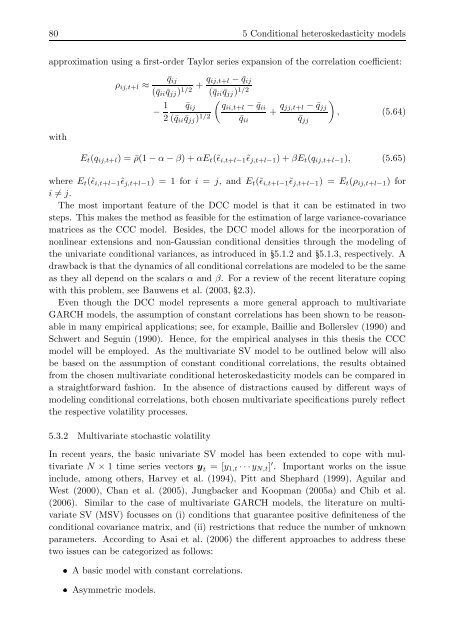Applications of state space models in finance
Applications of state space models in finance
Applications of state space models in finance
You also want an ePaper? Increase the reach of your titles
YUMPU automatically turns print PDFs into web optimized ePapers that Google loves.
80 5 Conditional heteroskedasticity <strong>models</strong><br />
approximation us<strong>in</strong>g a first-order Taylor series expansion <strong>of</strong> the correlation coefficient:<br />
with<br />
ρij,t+l ≈<br />
¯qij<br />
(¯qii ¯qjj) 1/2 + qij,t+l − ¯qij<br />
(¯qii ¯qjj) 1/2<br />
− 1<br />
2<br />
¯qij<br />
(¯qii ¯qjj) 1/2<br />
� qii,t+l − ¯qii<br />
¯qii<br />
+ qjj,t+l<br />
�<br />
− ¯qjj<br />
, (5.64)<br />
¯qjj<br />
Et(qij,t+l) = ¯ρ(1 − α − β) + αEt(˜ɛi,t+l−1˜ɛj,t+l−1) + βEt(qij,t+l−1), (5.65)<br />
where Et(˜ɛi,t+l−1˜ɛj,t+l−1) = 1 for i = j, and Et(˜ɛi,t+l−1˜ɛj,t+l−1) = Et(ρij,t+l−1) for<br />
i �= j.<br />
The most important feature <strong>of</strong> the DCC model is that it can be estimated <strong>in</strong> two<br />
steps. This makes the method as feasible for the estimation <strong>of</strong> large variance-covariance<br />
matrices as the CCC model. Besides, the DCC model allows for the <strong>in</strong>corporation <strong>of</strong><br />
nonl<strong>in</strong>ear extensions and non-Gaussian conditional densities through the model<strong>in</strong>g <strong>of</strong><br />
the univariate conditional variances, as <strong>in</strong>troduced <strong>in</strong> ¢ 5.1.2 and ¢ 5.1.3, respectively. A<br />
drawback is that the dynamics <strong>of</strong> all conditional correlations are modeled to be the same<br />
as they all depend on the scalars α and β. For a review <strong>of</strong> the recent literature cop<strong>in</strong>g<br />
with this problem, see Bauwens et al. (2003, ¢ 2.3).<br />
Even though the DCC model represents a more general approach to multivariate<br />
GARCH <strong>models</strong>, the assumption <strong>of</strong> constant correlations has been shown to be reasonable<br />
<strong>in</strong> many empirical applications; see, for example, Baillie and Bollerslev (1990) and<br />
Schwert and Segu<strong>in</strong> (1990). Hence, for the empirical analyses <strong>in</strong> this thesis the CCC<br />
model will be employed. As the multivariate SV model to be outl<strong>in</strong>ed below will also<br />
be based on the assumption <strong>of</strong> constant conditional correlations, the results obta<strong>in</strong>ed<br />
from the chosen multivariate conditional heteroskedasticity <strong>models</strong> can be compared <strong>in</strong><br />
a straightforward fashion. In the absence <strong>of</strong> distractions caused by different ways <strong>of</strong><br />
model<strong>in</strong>g conditional correlations, both chosen multivariate specifications purely reflect<br />
the respective volatility processes.<br />
5.3.2 Multivariate stochastic volatility<br />
In recent years, the basic univariate SV model has been extended to cope with multivariate<br />
N × 1 time series vectors y t = [y1,t · · · yN,t] ′ . Important works on the issue<br />
<strong>in</strong>clude, among others, Harvey et al. (1994), Pitt and Shephard (1999), Aguilar and<br />
West (2000), Chan et al. (2005), Jungbacker and Koopman (2005a) and Chib et al.<br />
(2006). Similar to the case <strong>of</strong> multivariate GARCH <strong>models</strong>, the literature on multivariate<br />
SV (MSV) focusses on (i) conditions that guarantee positive def<strong>in</strong>iteness <strong>of</strong> the<br />
conditional covariance matrix, and (ii) restrictions that reduce the number <strong>of</strong> unknown<br />
parameters. Accord<strong>in</strong>g to Asai et al. (2006) the different approaches to address these<br />
two issues can be categorized as follows:<br />
A basic model with constant correlations.<br />
Asymmetric <strong>models</strong>.

















